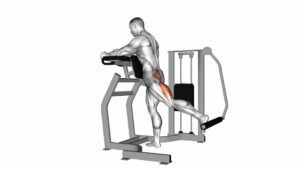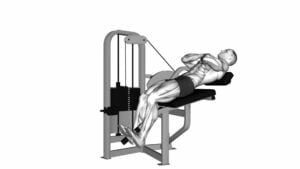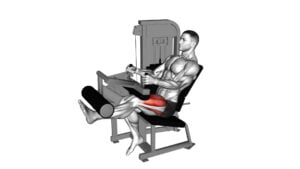Lever Hip Extension (VERSION 2) – Video Exercise Guide & Tips

In this video exercise guide, you'll learn how to perform Lever Hip Extension (VERSION 2) effectively.
Watch This Exercise Video
This exercise targets your hip muscles and can help improve your hip flexibility and strength.
All you need is a lever and some determination!
Follow our step-by-step instructions and avoid common mistakes to maximize the effectiveness of this exercise.
Get ready to take your hip extension to the next level with Lever Hip Extension (VERSION 2)!
Key Takeaways
- Lever Hip Extension targets multiple muscle groups simultaneously, including the glutes, hamstrings, and lower back.
- This exercise improves overall lower body strength and stability, enhancing athletic performance and power.
- Lever Hip Extension increases range of motion in the hip, aiding in injury prevention and rehabilitation.
- Proper form and technique, as well as engaging the core and glute muscles, are essential for maximizing the effectiveness of this exercise.
Benefits of Lever Hip Extension (VERSION 2)
You can experience several benefits from performing the lever hip extension exercise (VERSION 2). One of the advantages is the ability to target multiple muscle groups simultaneously. This exercise primarily works the glutes, hamstrings, and lower back. By engaging these muscles, you can improve your overall lower body strength and stability.
Another benefit of lever hip extension exercises is their versatility. There are various variations that you can incorporate into your workout routine to keep it challenging and prevent boredom. For example, you can perform the exercise with a resistance band or add weights to increase the intensity. These variations allow you to target different areas of the hips and glutes, helping you develop a well-rounded lower body.
Incorporating lever hip extension into a full body workout routine is also beneficial. This exercise engages multiple muscle groups, including the core and upper body, as they help stabilize your body during the movement. This integration promotes overall strength and coordination, making it an excellent addition to any comprehensive workout plan.
Now that you understand the benefits of lever hip extension exercises, it's time to discuss the equipment needed for this exercise (VERSION 2).
Equipment Needed for Lever Hip Extension (VERSION 2)
To perform lever hip extension (VERSION 2), you'll need a lever machine or a cable machine with an ankle attachment. Here are the equipment and tools you'll require to properly execute this exercise:
- Lever machine: This is the primary equipment needed for lever hip extension. It provides the necessary resistance and stability to target your hip muscles effectively.
- Cable machine with ankle attachment: If you don't have access to a lever machine, a cable machine with an ankle attachment can serve as an alternative. It allows you to perform the lever hip extension movement with similar mechanics.
- Adjustable weight stack: Both the lever machine and cable machine should have an adjustable weight stack. This feature enables you to increase or decrease the resistance according to your fitness level.
- Ankle attachment: This attachment is crucial for securing your ankle to the machine. It ensures stability and proper alignment during the lever hip extension exercise.
It is important to note that proper form is essential in lever hip extension to maximize its benefits and reduce the risk of injury. Always maintain a neutral spine, engage your core, and focus on using your hip muscles to move the lever or cable.
If you don't have access to the necessary equipment, alternative exercises for hip extension include glute bridges, hip thrusts, and Romanian deadlifts.
Step-by-Step Guide for Lever Hip Extension (VERSION 2)
Begin the lever hip extension (VERSION 2) exercise by adjusting the lever machine or cable machine to the appropriate weight and securing the ankle attachment. Stand facing the machine with your feet shoulder-width apart. Grab onto the handles or the sides of the machine for stability.
To perform the lever hip extension (VERSION 2), start by flexing your hip and knee, bringing your thigh parallel to the ground. This is your starting position. From here, extend your hip by pushing your leg back until it's straight, while keeping your knee slightly bent. Hold the contraction for a moment before returning to the starting position.
For progression options, you can increase the weight on the machine or cable as you become stronger. You can also perform the exercise on one leg at a time to increase the intensity. Additionally, you can try different variations of the exercise, such as using resistance bands or adding a stability ball for an extra challenge.
Modifications for lever hip extension (VERSION 2) include using lighter weights or resistance bands if the exercise feels too challenging. You can also decrease the range of motion by not fully extending your hip or by performing the exercise in a seated position.
Now that you know how to perform the lever hip extension (VERSION 2) exercise, let's move on to the next section about common mistakes to avoid during the exercise.
Common Mistakes to Avoid During Lever Hip Extension (VERSION 2)
One common mistake to avoid during lever hip extension (VERSION 2) is improper form. Maintaining proper form is crucial to maximize the benefits of this exercise and minimize the risk of injury.
Here are some common errors and form tips to help you perform lever hip extension (VERSION 2) correctly:
- Arching your back: Avoid overarching your lower back as this can strain your spine. Keep your spine neutral throughout the movement.
- Using momentum: Resist the temptation to use momentum to lift your legs. Instead, focus on engaging your hip muscles to control the movement.
- Raising your legs too high: Be cautious not to lift your legs higher than your torso. This can place excessive stress on your lower back.
- Neglecting core engagement: Remember to engage your core muscles by drawing your belly button in towards your spine. This will provide stability and support during the exercise.
By avoiding these common errors and implementing these form tips, you can perform lever hip extension (VERSION 2) effectively and safely.
Remember to always start with a weight that challenges you but allows you to maintain proper form. As you progress, you can gradually increase the weight to continue challenging your hip muscles.
Tips to Maximize the Effectiveness of Lever Hip Extension (VERSION 2)
To maximize the effectiveness of lever hip extension (VERSION 2), focus on engaging your glute muscles and maintaining proper form throughout the exercise. Engaging the glute muscles is essential because they're the primary muscles targeted during the lever hip extension. By consciously activating and contracting your glutes, you can ensure that you're effectively working these muscles and maximizing the benefits of the exercise.
One common misconception about lever hip extension (VERSION 2) is that it's solely a hamstring exercise. While the hamstrings are involved in the movement, the glutes play a more significant role. Therefore, it's crucial to prioritize glute engagement to achieve optimal results.
Additionally, there are variations and modifications you can incorporate to enhance the effectiveness of lever hip extension (VERSION 2). One variation is to perform the exercise with a resistance band around your thighs, adding extra resistance and targeting the glute muscles even more. Another modification is to increase the range of motion by extending your hip fully and squeezing your glutes at the top of the movement.
Remember to maintain proper form throughout the exercise, keeping your core engaged and your back straight. Avoid using momentum or relying on other muscle groups to perform the movement. By focusing on engaging your glute muscles and making these small adjustments, you can maximize the effectiveness of lever hip extension (VERSION 2) and achieve optimal results.
Frequently Asked Questions
How Many Sets and Repetitions Should I Do for Lever Hip Extension (Version 2)?
To determine the suitable number of sets and repetitions for lever hip extension (version 2), consider your fitness level and goals.
Start with 2-3 sets of 10-15 repetitions and gradually increase as you get stronger.
This exercise targets the glutes, hamstrings, and lower back, improving hip stability and power.
Athletes can benefit from increased explosiveness and lower body strength.
Remember to consult a fitness professional to ensure proper form and suitable modifications.
Can Lever Hip Extension (Version 2) Help Improve My Running Speed?
Lever hip extension (version 2) can have a positive impact on your running speed and overall athletic performance.
Compared to other exercises, lever hip extension (version 2) specifically targets the muscles involved in hip extension, which is crucial for generating power and propelling yourself forward while running.
Is Lever Hip Extension (Version 2) Suitable for People With Lower Back Pain?
If you have lower back pain, lever hip extension (version 2) may not be suitable for you. However, there are alternative exercises that can help strengthen your hips without putting too much strain on your lower back.
It's important to consult with a healthcare professional or a certified trainer who can guide you in finding the right exercises for your condition. Incorporating lever hip extension (version 2) into a rehabilitation program for lower back pain can have benefits, but it should be done under proper supervision.
How Long Should I Rest Between Sets of Lever Hip Extension (Version 2)?
To optimize muscle activation and allow for sufficient recovery, it's important to consider the rest duration between sets of lever hip extension (version 2).
The appropriate rest duration can vary depending on your fitness level and goals. Generally, a rest duration of 30-90 seconds is recommended to allow for partial recovery of the muscles involved while maintaining a level of fatigue for continued muscle activation.
Adjust the rest duration based on your individual needs and preferences.
Can Lever Hip Extension (Version 2) Be Modified for Beginners or Those With Limited Mobility?
Yes, lever hip extension (version 2) can be modified for beginners or those with limited mobility. Modified variations of this exercise can be performed with reduced range of motion or by using resistance bands for assistance.
These modifications allow individuals to gradually build strength and mobility in their hip muscles. Lever hip extension (version 2) offers benefits such as improved lower body strength and stability, making it an effective exercise for overall lower body development.
Conclusion
In conclusion, Lever Hip Extension (Version 2) is a highly effective exercise for strengthening the hip muscles and improving overall lower body stability.
By following the step-by-step guide and avoiding common mistakes, individuals can maximize the effectiveness of this exercise.
With the right equipment and proper technique, Lever Hip Extension (Version 2) can provide numerous benefits, including improved hip mobility, enhanced athletic performance, and reduced risk of injury.
Incorporate this exercise into your fitness routine for optimal results.

Author
Years ago, the spark of my life’s passion ignited in my mind the moment I stepped into the local gym for the first time. The inaugural bead of perspiration, the initial endeavor, the very first surge of endorphins, and a sense of pride that washed over me post-workout marked the beginning of my deep-seated interest in strength sports, fitness, and sports nutrition. This very curiosity blossomed rapidly into a profound fascination, propelling me to earn a Master’s degree in Physical Education from the Academy of Physical Education in Krakow, followed by a Sports Manager diploma from the Jagiellonian University. My journey of growth led me to gain more specialized qualifications, such as being a certified personal trainer with a focus on sports dietetics, a lifeguard, and an instructor for wellness and corrective gymnastics. Theoretical knowledge paired seamlessly with practical experience, reinforcing my belief that the transformation of individuals under my guidance was also a reflection of my personal growth. This belief holds true even today. Each day, I strive to push the boundaries and explore new realms. These realms gently elevate me to greater heights. The unique combination of passion for my field and the continuous quest for growth fuels my drive to break new ground.







